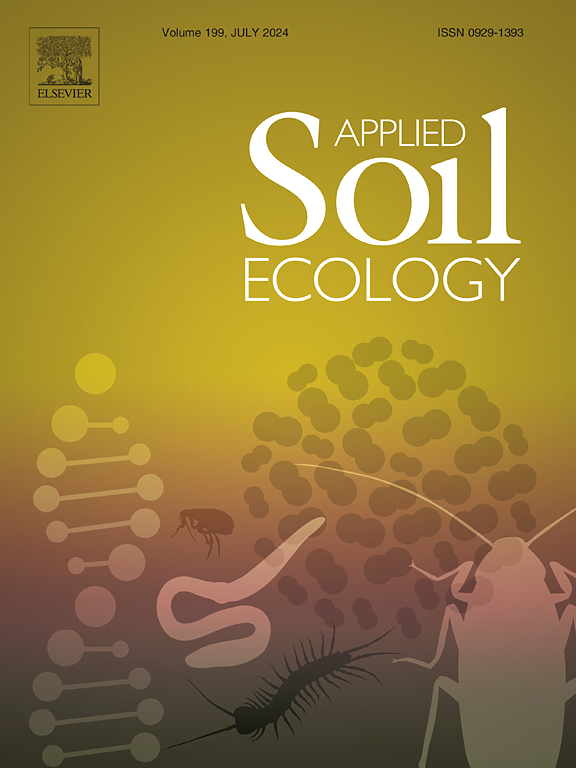梅朵降解减少了微生物 β 的多样性和网络的复杂性,同时增强了网络的稳定性
IF 4.8
2区 农林科学
Q1 SOIL SCIENCE
引用次数: 0
摘要
在气候变化和人类活动的双重影响下,草甸持续退化,改变了微生物介导的生物地球化学循环。然而,人们对草甸退化所导致的微生物多样性和网络稳定性以及它们与环境变量之间的关系仍然了解不足。本研究以青藏高原腹地不同退化程度的高寒草甸为研究对象。研究分析了高寒草甸退化过程中的土壤微生物多样性(α和β多样性)和生态网络拓扑特征。此外,还探讨了这些因素在多大程度上解释了退化过程中观察到的环境变化。结果表明(1) 在高山草甸退化过程中,土壤微生物的 α 多样性呈上升趋势,但并不显著。β 多样性(群落差异性)呈显著下降趋势。这表明草甸退化导致群落内和群落间的微生物同质化。在轻度退化阶段,细菌和真菌的β多样性随着地理和环境距离的增加而显著增加。只有细菌的β多样性在中度退化阶段和重度退化阶段分别随地理距离和环境距离的增加而明显增加。这表明草甸退化可能改变了微生物的组合,尤其是真菌。(2)土壤细菌节点度随退化程度呈显著下降趋势,真菌特征中心度也呈显著下降趋势。剔除相同节点后,真菌网络的自然连通性随降解呈显著下降趋势。这表明,在草甸退化的情况下,土壤微生物网络的稳定性增强,而网络的复杂性降低。这些变化可能标志着高山草甸退化的不可逆过程。(3)Mantel 检验表明,细菌多样性和网络拓扑特征与环境因素的相关性比真菌更强。基于冗余分析(RDA)的阿凯克信息准则(AIC)值和方差分配失调矩阵图表明,土壤 pH 值、有机碳(SOC)含量和全钾(TK)等土壤因子的比率越高,微生物群落多样性和网络拓扑特征的变化就越明显。这项研究强调了土壤微生物对生态稳定性的重要性,在未来恢复高寒草地的工作中应重视微生物的作用。本文章由计算机程序翻译,如有差异,请以英文原文为准。

Meadow degradation reduces microbial β diversity and network complexity while enhancing network stability
Continuing meadow degradation under the dual impacts of climate change and human activities has altered microbially-mediated biogeochemical cycles. However, microbial diversity and network stability in response to meadow degradation and their relationships to environmental variables remain insufficiently understood. This study focused on alpine meadows with varying degrees of degradation in the hinterland of the Qinghai-Tibetan Plateau. It analyzed the soil microbial diversity (α and β diversity) and ecological network topology characteristics under the degradation of alpine meadows. Furthermore, the extent to which these factors elucidate the environmental changes observed during degradation was explored. The results demonstrated that: (1) the α diversity of soil microbial under degradation of alpine meadows exhibited an increasing trend, although not significantly. The β diversity (community dissimilarity) exhibited a significant decreasing trend. These indicated that meadow degradation resulted in microbial homogenization intra- and inter-community. In the light degradation stage, the β diversity of bacteria and fungi significantly increased with geographic and environmental distance rise. Only bacterial β diversity significantly increased with geographical distance in the moderate degradation stage and environmental distance in the heavy degradation stage, respectively. This indicated that meadow degradation possibly altered microbial assembly, especially for fungi. (2) The degree of soil bacterial nodes exhibited a significant decreasing trend with degradation and fungal eigencentrality demonstrated a significant decreasing trend. After removing the identical nodes, the natural connectivity of the fungal network exhibited a significant decreasing trend with degradation. This suggested that the stability of the soil microbial network increased while the network complexity decreased under meadow degradation. These changes possibly marked the irreversible course of alpine meadow degradation. (3) The Mantel test indicated that bacterial diversity and network topological features were more strongly associated with environmental factors than those of fungi. Akaike information criterion (AIC) values and the upset matrix plots of variance partitioning based on Redundancy analysis (RDA) indicated that higher rates of soil factors, such as soil pH, organic carbon (SOC) content, and total potassium (TK), elucidated changes in microbial community diversity and network topological features. This study highlights the importance of soil microorganisms for ecological stability and the role of microorganisms should be emphasized in future efforts to restore alpine grasslands.
求助全文
通过发布文献求助,成功后即可免费获取论文全文。
去求助
来源期刊

Applied Soil Ecology
农林科学-土壤科学
CiteScore
9.70
自引率
4.20%
发文量
363
审稿时长
5.3 months
期刊介绍:
Applied Soil Ecology addresses the role of soil organisms and their interactions in relation to: sustainability and productivity, nutrient cycling and other soil processes, the maintenance of soil functions, the impact of human activities on soil ecosystems and bio(techno)logical control of soil-inhabiting pests, diseases and weeds.
 求助内容:
求助内容: 应助结果提醒方式:
应助结果提醒方式:


